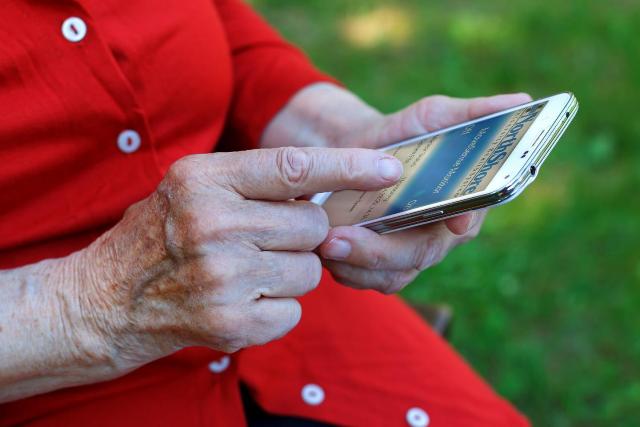Jul 23 2015
Patients suffering from chronic cardiopulmonary diseases could soon have a solution to help them accurately monitor their health and warn doctors at the first sign of trouble.
 U of I team developed a smartphone app, MoveSense, which monitors cardiopulmonary patients by analyzing the way they walk then predicts their oxygen saturation level -- without the use of a pulse oximeter. Credit: © University of Illinois College of Medicine at Urbana-Champaign
U of I team developed a smartphone app, MoveSense, which monitors cardiopulmonary patients by analyzing the way they walk then predicts their oxygen saturation level -- without the use of a pulse oximeter. Credit: © University of Illinois College of Medicine at Urbana-Champaign
By simply carrying their cellphone, equipped with the health-tracking app, MoveSense, developed by researchers at the University of Illinois at Urbana-Champaign, a patient's oxygen saturation level can be passively monitored with medical accuracy.
Oxygen saturation is a standard measure of health status, the single most important clinical measure. Unlike other methods of measuring oxygen saturation levels, which detect sharp drops causing desaturation, MoveSense continuously monitors saturation, making the resultant patterns possible to model accurately--and the patient is only required to carry a smart phone while walking.
Led by Bruce Schatz, the head of medical information science at the College of Medicine at Urbana-Champaign and a professor of computer science, the team published its findings in the journal Telemedicine and e-Health, the official journal of the American Telemedicine Association. Authors included students from the College of Engineering and physicians from Carle Foundation Hospital in Urbana, Ill., where the patient testing was performed.
The ability to accurately measure oxygen saturation without the use of a pulse oximeter is something that has never been achieved, until now."The ability to accurately measure oxygen saturation without the use of a pulse oximeter is something that has never been achieved, until now. The oximeter, a non-invasive medical device usually placed on the patient's finger, measures the proportion of oxygen in the blood, combining status of the two major circulatory systems, the heart and the lung. The saturation level is an overall measure of the patient's cardiopulmonary fitness," said Schatz, who also is affiliated with the Institute for Genomic Biology, where the data analysis was performed.
This medical discovery was made with the aid of findings from one of Schatz's previous discoveries that revealed phone sensors can accurately measure walking patterns, also known as gait.
Doctors often use an assessment called the six-minute walk test for patients with heart and lung disease, such as congestive heart failure (CHF), chronic obstructive pulmonary disease (COPD) and asthma. The test provides information regarding a patient's functional capacity and response to therapy for a wide range of chronic cardiopulmonary conditions.
The Illinois team used MoveSense, in conjunction with their existing gait model, to administer six-minute walk tests to 20 patients with cardiopulmonary disease.
Patients wore pulse oximeters (so readings could be compared to MoveSense data) and carried smartphones running MoveSense software, which continuously recorded saturation and motion. Continuous saturation defined categories corresponding to status levels, including transitions. This, by itself, was a new medical observation. Continuous motion was used to compute eight gait parameters from the sensor data. Their existing gait model was then trained with these data points and used to predict transitions in oxygen saturation.
The researchers discovered oxygen saturation readings clustered patients into three pulmonary function categories: one with consistently high saturation, one with consistently low saturation, and a third where saturation varied and patients were clinically unstable. In addition, they discovered that analysis of the saturation, combined with the gait data, could predict saturation category with 100 percent accuracy. The model uses a voting scheme to account for patients walking faster and slower, as their hearts and lungs struggle to keep up with demand.
The ability to predict the saturation category of the patient internally from motion of the patient externally is remarkable. This new capability will allow medical professionals to monitor patients' vital signs, predict their clinical stability, and act quickly should their condition decline. Patients need only carry their personal phones during daily living, as testing has shown that periodic samples are sufficient and that even inexpensive smartphones are powerful enough to record these.
"Given our previous success with predictive modeling of gait with chronic lung disease patients, and our knowledge of the correlation between gait speed and oxygen desaturation in walk tests, we knew if we could passively and continuously record oxygen saturation using a smartphone, we could predict cardiopulmonary status in a medically accurate and economical way," said Schatz, "A discovery like this will impact general medicine, many medical specialties, and the lives of millions of people suffering from chronic cardiopulmonary diseases."